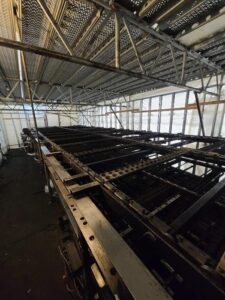Case Study: Dry Ice Blasting Used for WINMAR Fire Restoration Project
Technique Used: Dry Ice Blasting
Location: Toronto, Ontario
Service: Commercial Fire Restoration
A serious fire at a commercial food processing plant that damages production equipment and contaminates a facility with soot is a near disaster for the company that suffers it. Production comes to an immediate halt. Thousands of pounds of finished products, raw materials, and ingredients must be disposed of. Employees are put out at work, and customers are immediately forced to look elsewhere for alternative suppliers. The facility must be restored to the high standards set by food inspection agencies before it can begin production again.
Fire restoration is a complex project where industrial cleaners, engineers, electricians, plumbers, and sanitation experts work together to save the business.
This was the case recently when Wickens Dry Ice Blasting was hired as one of many subcontractors by WINMAR; the property restoration company tasked with a large loss fire restoration project in a commercial bakery in Toronto, Ontario.

THE SITUATION
The fire broke out in one of two large baking ovens from the heart of the company’s production process. One oven was severely damaged, while the second oven was completely contaminated and rendered unusable. Because of the nature of the product, the production of soot was overwhelming and, driven by the air system, contaminated the entire facility, including other production and packaging equipment and the warehouse facility shelving.
THE SOLUTION

To begin with, the facility was emptied of its contents. The cleaning started with a combination of Wickens Dry Ice Blasting, other industrial cleaners, and a small army of people cleaning surfaces by hand. Dry ice was used to clean ceilings, walls, shelving, and other hard-to-reach areas. Having a structural complexity made hand cleaning extremely difficult. A total of six teams from Wickens Dry Ice Blasting worked around the clock along with the other workforce deployed by WINMAR and, within two weeks, the facility was cleaned and passed inspection.
While the facility cleaning was going on, full containment tents were built over the top of the two ovens to continue working on them without re-contaminating the facility. Once the facility cleaning was complete, Wickens moved into the containment and worked on the damaged oven itself. Within a few days, the second oven was functional, and within eight days, the first oven’s 250 linear foot conveyor system and its interior were cleaned and ready for repair.

Dry ice blasting is a blasting technology analogous to grit or water blasting except that, because of the cryogenic properties of dry ice, it leaves no surface residue and no secondary waste. The dry ice pellets, propelled at high speed and high pressure, sublimate on contact expanding by volume 400 times. This combination of the kinetic energy of a solid striking a solid and the instant sublimation creates an impact flush cleaning dynamic that flows onto the surface is like water blowing of contaminants.
The great value of dry ice blasting in this kind of situation, aside from its apparent benefits of non-conductivity and non-abrasive cleaning, is that it allows for the seamless integration of blast cleaning into a multi-faceted workspace. Having all facets of the restoration occurring simultaneously shaves weeks, even months off, the total time required to have the company back up and running.
THE RESULT
Wickens’ fire restoration services using dry ice blasting were cost-effective. We successfully decontaminated the entire facility so production could resume in under two weeks. Our equipment and services were superior to other companies, which prompted WINMAR to select us to restore the oven that had caught fire.
Wickens Dry ice Blasting tackles the toughest jobs across Ontario, offering fire restoration, mould remediation, asbestos abatement, lead paint abatement, and more. Contact us today for a consultation or emergency fire restoration needs.
- Happy Holidays from Wickens - December 20, 2023
- Maximize Your Year-End Shutdown: The Ideal Time for Industrial Cleaning with Dry Ice Blasting - November 24, 2023
- Introducing the Viking 4000 – A Game Changer in Dry Ice Blasting - July 28, 2023
